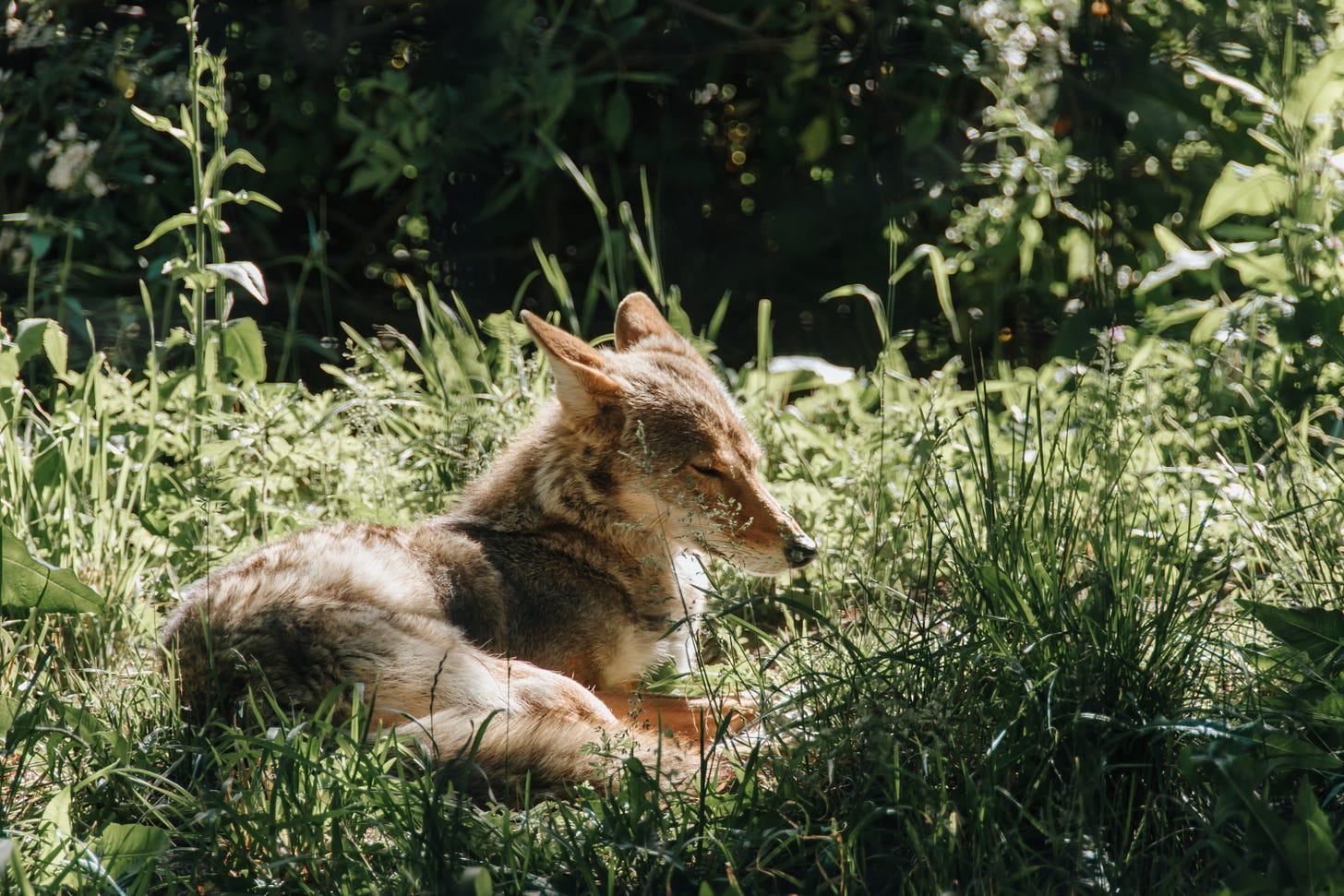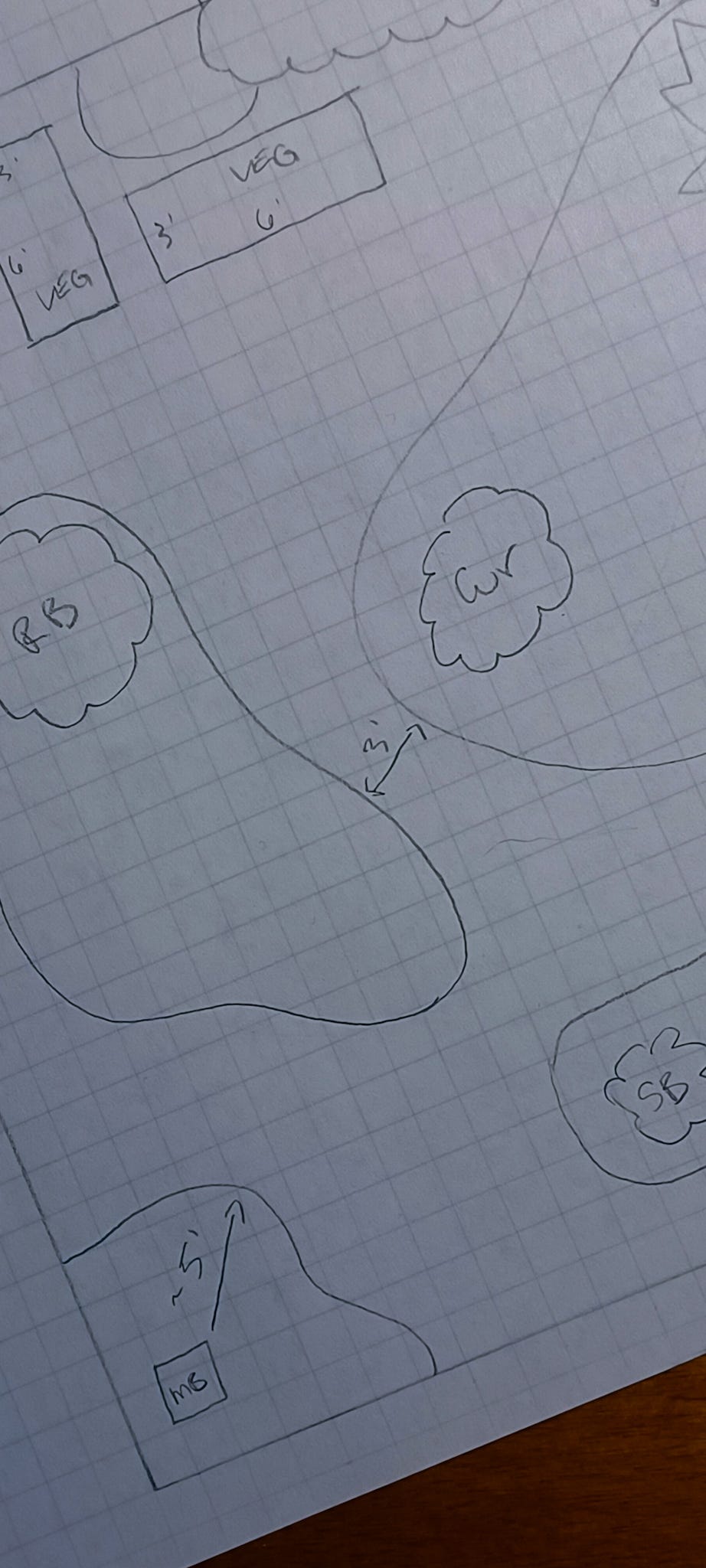If you have been reading this newsletter for a minute, you have seen me complaining about the rabbits in my yard. Even more than the fact that they have completely destroyed my pepper and eggplant starts, the thing that bothers me most is their unapologetic boldness. Even the young ones! Yesterday I walked outside and a smol bean rabbit baby was sound asleep on my herb spiral. Passed out after a hard day of snacking on my garden buffet. Didn’t even get up as I walked towards it.
There is a saying common to permaculture handbooks: You don’t have an excess of [x], you have a deficiency of [y]. I think the famous example is along the lines of: You don’t have a slug infestation in your garden, you just have a duck deficiency. Get it? - because ducks eat slugs. So in this case: I don’t have an excess of rabbits, I just have an unfortunate deficiency of coyotes.
I’m worried about the coyotes that used to frequent the areas around our house. For the last four years we’d hear them regularly through the open windows in the early part of the night. Coyotes get that delightful designation: crepuscular, which means they are most active around nightfall and dawn. The three of us: me, my partner Jordan, and our cat Frida all falling silent and still to listen to their unearthly yipping.
One time Jordan and I were outside in the yard after dark and heard a coyote send up a howl half a mile away. The answering howl came from the dark so close to us, startlingly close, from just outside the edge of the barn light, just out of sight. How often are we right next to a coyote without knowing it?
But as of this writing it’s been quite a few months since we’ve heard the coyotes, and I fear the worst. People love to kill coyotes - over half a million a year according to Project Coyote. Killing contests take place legally in forty states in the U.S., which reward the person who can kill the most coyotes. I am not opposed to game hunting but I think mass killings like this are pretty horrifying.
Part of the reason I think this happens is that they’re perceived as a pest and a threat to small dogs and outdoor cats and chickens - animals which are the trappings of the domestic lives of people. Coyotes remain outside that sphere but their terrain overlaps with it, sometimes to an unexpected degree.

Coyote is all over the myths and legends of the Americas; he’s the one that created all the other animals, according to the Miwok creation myth. A trickster, a teacher. “Part of the trickster mystique is the refusal to be defined,” Lyanda Lynn Haupt says. “Tricksters dwell in a self-made amoral world, neither good nor bad, and in a tangle of contradiction[.]” One who dwells in the both-and, one who can walk between worlds - a psychopomp of sorts, perhaps.
One time I sat with my friend Dana on his dark porch drinking beers and enjoying a muggy evening in the middle of metro Atlanta. We fell silent when pair of coyotes on some secret errand trotted casually up the middle of the street, illuminated by the streetlights humming in the lush southern heat. As they made their way out of sight and further into the neighborhood all the yard dogs sent up their big barks of alarm. Intruders! Already evaporated into the city night.
Everyone has stories like this. The thing is that there is no clean break between the city and the country - these are porous things. In his book The Way of Coyote, Gavin Van Horn notes that these two entities, perceived as opposites, actually create each other. In the case of the coyote, the more that humans spread further and further into the countryside the more and more that we will find these wild animals in our midst in our most densely populated places.
Tagging has allowed scientists to watch and study coyotes, and they’ve learned that there are more coyotes thriving right under the noses of city-dwellers than one might ever think possible - literal hundreds under surveillance in metro Chicago. They have learned to stop at stoplights. They have learned to stop at stoplights!!! Van Horn again: “more people are finding out what is known among coyotes: wildness is part of the city, if you know how to look for it.”
But the thing that makes me appreciate coyotes the most, personally, is that they tend to like to shit right in the middle of the trail. Have you noticed that, too? It’s like they pick the place most likely to be walked over by humans and take a morning constitutional right there. It is a delightful bit of trickster noncompliance. A fun little fuck-you. I love it so much.
The other fuck-you to humans is that the more the coyote is hunted and killed off, the more coyotes there actually are. And this is a good thing, because coyotes are a keystone species, which means if you kill them all the food chain falls out of whack. The rabbits procreate…well, like rabbits. And those rabbits needs to eat an amount of food proportional to the birth rate increase (in this case, to the extreme detriment of my garden - but also to the native plants that call my yard home) which has a domino effect on the rest of the food chain. This domino effect is called a trophic cascade, which sounds pretty but is a terrible outcome.
This ability to reproduce at higher rates, having bigger litters when their brethren are being locally exterminated, is an incredible evolutionary response to conditions of feast and famine. Sometimes when coyotes howl, they are listening for other nearby coyotes to respond (“a coyote census,” one account described). If they don’t hear any neighboring coyotes, the mothers will have bigger litters, more pups, when they give birth. Clearly, the continual attempts at eradicating them are not only unsuccessful, they are only encouraging there to be more and more coyotes.
Coyotes deserve a place in this world, like every other living thing. Rather than trying to get rid of them en masse - which is not only senselessly cruel but also is literally backfiring - we should respect them and work to live alongside them. Bring the cat in before dusk. Secure the garbage cans. Preserve large swathes of land so that they have space to roam and live their mysterious coyote lives.
A coyote welcomed us to our house here in central Illinois, in their ghostly way. I have written before about the emotion turmoil and upheaval that came with me when I arrived here. What the fuck am I doing? Is this all an extended series of terrible mistakes? The first night in the new house, after coaxing Frida out from under the basement stairs, surrounded by all our boxed belongings, I noticed the tracks in the porch light outside on the concrete patio through the glass front door. It had rained earlier, the ground was still muddy. A single set of paw prints - distinctly ovoid, indicating coyote, not dog - came up onto the patio and seemed to stop in front of the front door, looking into the house for an unknown amount of time before continuing on their way.
I want to end with this quote by Lyanda Lynn Haupt from The Urban Bestiary:
“Coyote represents a sensibility that does not stay neatly inbounds. Coyote is both wholly other and an intricate part of our human story. Coyote will inspire our poems. Coyote will eat our cats. Coyote’s life is messy, wary, prancing, a life that cannot avoid pain, or death, or dirt, but is nevertheless enlivening: ears pricked, alert, lean, wild, delighted.”
If you want to learn more about coyotes and how to protect them, check out Project Coyote and get involved. And! If you have more coyote facts and coyote stories I would love if you would share them in the comments.
What I’m working on:
I’ve been creating a yard design for a friend who just moved into a house with a big front lawn that she wants to replace with native plants that support local pollinators, while still keeping it tidy-looking for the neighbors. The site has been a fun challenge because of its interacting restrictions: the yard is in full shade for most of the day, and while there is a hose hook-up nearby, I am always trying to design for the fewest number of required inputs which means that I’m recommending only plants that are drought-tolerant once they’re established. There are some plants that famously fruit in full shade, like currant bushes, but really fleshing out that list more fully feels a little bit like a puzzle, which I have thoroughly loved working on.
Next up is another lawn-to-native plant transformation, this time in Decatur, Georgia. I’m excited to get working on it!
I will be available for hire for new garden designs starting in August. My services may be helpful to you if:
You want less lawn and more native plants but don’t know where to start
You want to support your local ecosystem but don’t want your neighbors or HOA to get mad at you
You want an edible yard that feeds humans, birds, butterflies, and soil microbes (and everyone in between on the food chain!)
You don’t want to spend an arm and a leg on landscapers but you’re not sure how to put your yard dreams into action
Just respond to this email if you’d like more information and we can see if it’s a good fit!
Thanks for reading - see ya next time.





